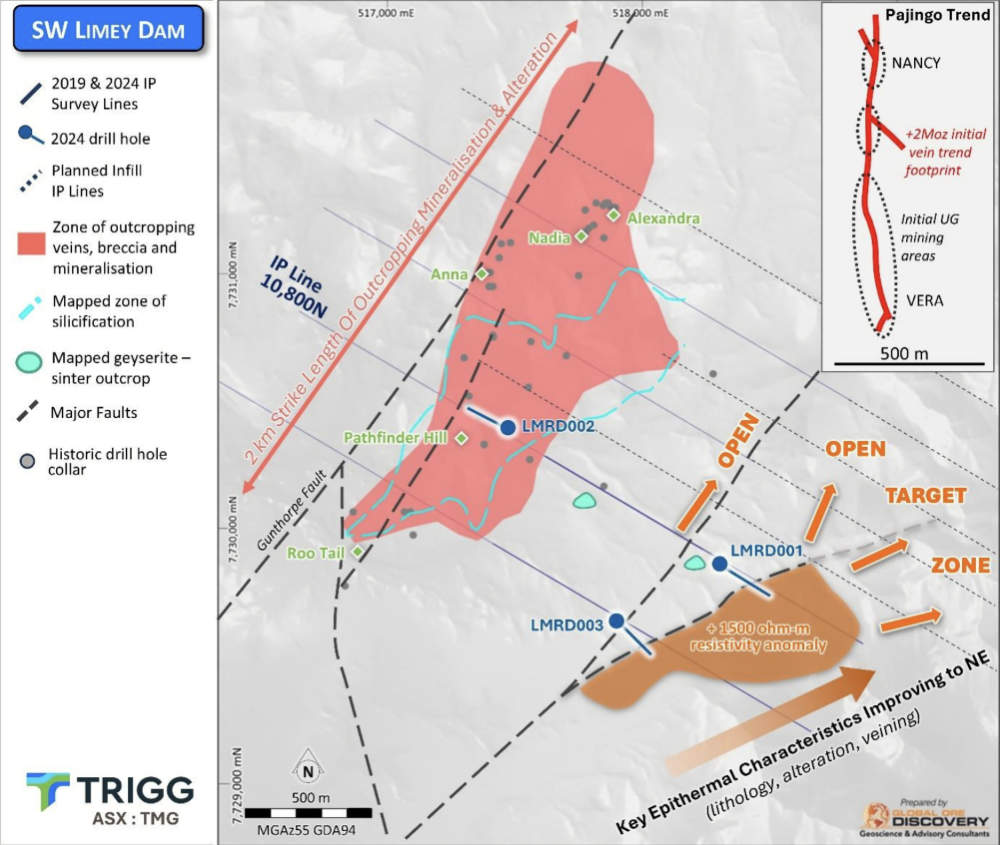Trigg Minerals’ tasty new epithermal system highlights Old Glenroy gold project potential

Tastier than chips and gravy – Trigg’s new epithermal system at SW Limey appears to intensify towards the northeast. Pic: Getty Images
- Trigg Minerals’ drilling uncovers new epithermal system at the SW Limey prospect within its Old Glenroy gold project
- Vectoring of the alteration intensity suggests the low-sulphidation intensifies to the northeast
- Previous survey lines to be extended and infilled to the northeast to further define exploration drill targets
Special Report: Drilling to test induced polarisation anomalies at the SW Limey and Breccia Hill targets within Trigg Minerals’ Old Glenroy gold project in Queensland has discovered a new epithermal system.
The first drill hole (LMRD001) at SW Limey – a previously undrilled IP analogue to the 5Moz Pajingo deposit with historical vein sampling results of up to 54.4g/t gold – intersected a significant zone of alteration from 160m to the end of hole at 402m.
Trigg Minerals IASX:TMG) said preliminary results from LMRD001 and LMRD003 show multiple indicators for a low-sulphidation epithermal system existing along a previously untested IP-identified structure.
Importantly, vectoring of the alteration intensity between these two holes suggests that this system intensifies to the northeast.
“Trigg’s engagement and collaboration with the technical experts at Global Ore Discovery continues to result in rapid hits of exploration milestones on our Drummond Basin gold projects,” non-executive chairman Timothy Morrison said.
“The discovery of a new epithermal system is a fantastic technical success for Trigg with follow-up targeting along this new structural trend well-warranted.”

SW Limey exploration
Previous exploration at SW Limey consisted of four lines of pole-dipole IP in 2019, two of which were extended by 1km to the south-east in mid-2024 following reprocessing interpretation by consultancy Global Ore Discovery.
This work found that the controlling structure for the historically explored >4km epithermal vein trend manifests as a sharp, steep easterly dipping resistivity gradient and has not been optimally tested by historical drilling.
It also confirmed sharp resistivity breaks with strong chargeability highs towards the eastern extents of the extended IP lines 10400mN and 10800mN, which are consistent with the IP signature of highly fertile structures for low sulphidation epithermal veins, such as at Pajingo.
This led to the company drilling three holes to test the highly encouraging resistivity discontinuities and chargeability anomalies, assays for which are expected later this quarter.
Drilling at Breccia Hill, where IP surveying revealed coincident IP resistivity and chargeability anomalies beneath the southern and northern contacts of the historically mapped and shallowly drilled rhyolite breccia, was postponed after the first hole was terminated due to extensive drill bit wear.
Next steps
TMG plans to extend and infill previous survey lines to the north-east to further define exploration drill targets along strike of this newly established trend at SW Limey.
Spectral analysis will supplement geochemistry in defining the level of the intersections in the epithermal system.
Concurrently, the company is advancing its high-grade Wild Cattle Creek antimony deposit and Taylors Arm antimony portfolio.
This article was developed in collaboration with Trigg Minerals, a Stockhead advertiser at the time of publishing.
This article does not constitute financial product advice. You should consider obtaining independent advice before making any financial decisions.
Related Topics

UNLOCK INSIGHTS
Discover the untold stories of emerging ASX stocks.
Daily news and expert analysis, it's free to subscribe.
By proceeding, you confirm you understand that we handle personal information in accordance with our Privacy Policy.








